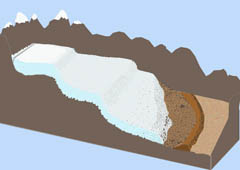
About 10% of the Earth’s land surface is covered by glaciers and ice sheets. Glaciers are large, thickened masses of ice that have accumulated from snowfall over long periods of time. When the ice masses reach a critical thickness, they may begin to move, or flow.
Glacial ice is formed where temperatures are low and snowfall is high. Such conditions may exist both at high altitudes, and at high latitudes. Even tropical and equatorial zones may have glaciers if the elevation is
high enough.
Glaciers grow when the winter snow accumulation exceeds snow loss during summer ablation. Ablation means the loss of snow and ice through melting, evaporation and/or calving. When the winter snowfall exceeds the summer ablation, a layer of snow is added. During summer, this layer goes through a metamorphosis; the snowgrains become larger. This layer is then called firn. With time new layers accumulate, and the snow beneath becomes more and more compact, and is slowly compressed by the above layers into crystalline ice.